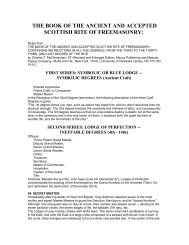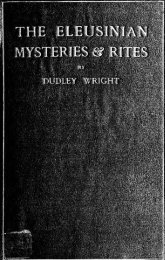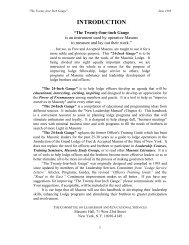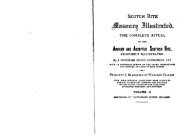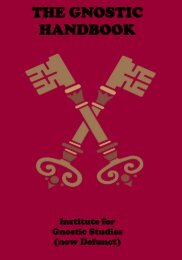The History of Initiation - The Masonic Trowel
The History of Initiation - The Masonic Trowel
The History of Initiation - The Masonic Trowel
You also want an ePaper? Increase the reach of your titles
YUMPU automatically turns print PDFs into web optimized ePapers that Google loves.
4: HISTORY OF INITIATION.<br />
But after the Flood the altar <strong>of</strong> Darkness 10 was arrayed<br />
against the altar <strong>of</strong> Light ; the patriarchal ordinances were<br />
perverted ; the rites <strong>of</strong> Buddha were engrafted on the<br />
pure ceremonies <strong>of</strong> the masonic ritual, 11 and the plains <strong>of</strong><br />
Shinar resounded with the frantic yellings <strong>of</strong> the rebellious<br />
Cuthites. 12<br />
By subsequent corruptions, the arkite<br />
rites thus boldly introduced, 13 at length assumed the more<br />
complex form <strong>of</strong> Brahmenism, 14 and were solemnized with<br />
winding apartments under ground, and which, as it is said, those who<br />
were skilled in ancient rites, foreseeing the coming <strong>of</strong> the Deluge, and<br />
fearing lest the memory <strong>of</strong> their ceremonies should be obliterated,<br />
built and contrived vaults, dug with vast labour, in several places ;<br />
cutting on the walls many sorts <strong>of</strong> birds and beasts, and innumerable<br />
kinds <strong>of</strong> animals, which they called hieroglyphical letters." (Vol. i.,<br />
p. 39.)<br />
10 It may be observed here, that in all the idolatrous systems. Dark-<br />
ness was honoured with peculiar marks <strong>of</strong><br />
veneration, by reason <strong>of</strong> its<br />
supposed priority <strong>of</strong> existence for ; those who were unable to extend<br />
their ideas beyond the creation <strong>of</strong> this world, always considered darkness<br />
to have been <strong>of</strong> greater antiquity than light; and hence their<br />
cosmogonies all commence with dark chaos. This principle was identified<br />
with the Great Mother, (for Venus and Night were the same<br />
individual deity, Orph. Hymn. 2.) who, representing equally the earth<br />
and the ark <strong>of</strong> Noah, remained enveloped in the blackest shades <strong>of</strong><br />
darkness, both before the creation and during the prevalence <strong>of</strong> the<br />
diluvian waters. (Vid. Signs and Symbols, by the Author <strong>of</strong> this<br />
Work, Lect. 6.) And this awful goddess was no other than the Isis,<br />
or Ceres, or Rhea, or Ceridwen <strong>of</strong> the Mysteries. (Signs and Symb.,<br />
pref.)<br />
"''<br />
It has been <strong>of</strong>ten<br />
"<br />
supposed," says Malcolm, that Buddhism<br />
resembles Brahmenism, which is a great mistake. No two systems<br />
can be more opposite, or bear less evidence <strong>of</strong> being derived from each<br />
other. Brahmenism has incarnations, but Buddhism admits <strong>of</strong> none,<br />
for it has no permanent god.<br />
That has a host <strong>of</strong> idols; this only one.<br />
That enjoins bloody sacrifices; this forbids all killing. That requires<br />
atrocious self tortures ; this inculcates few austerities. That makes<br />
lying, theft, and other vices sometimes commendable, and describes<br />
the gods as. excelling in those enormities; this never coufounds right<br />
and wrong, and never excuses any sin. That makes absorption into<br />
deity the supreme good this annihilation.<br />
;<br />
12 Faber contends that idolatry commenced at Babel, from that passage<br />
in which " the prophet <strong>of</strong> the Apocalypse styles Babylon or<br />
Babel, the mother <strong>of</strong> harlots and abominations <strong>of</strong> the earth ; (Rev.<br />
viii., 5.) by which is meant, in the figurative language <strong>of</strong><br />
scripture, that<br />
all the abominations <strong>of</strong> apostate idolatry originated from that city as<br />
from a common parent." (Pag. Idol., vol. i., p. 77.<br />
13<br />
Signs and Symbols, Lect. 5.<br />
14 <strong>The</strong> mysterious systems <strong>of</strong> polytheism branched <strong>of</strong>f into two great<br />
sects, which have been distinguished by mythologists, under the names<br />
<strong>of</strong> Buddhism and Brahmenism. each possessing its own peculiarities,



